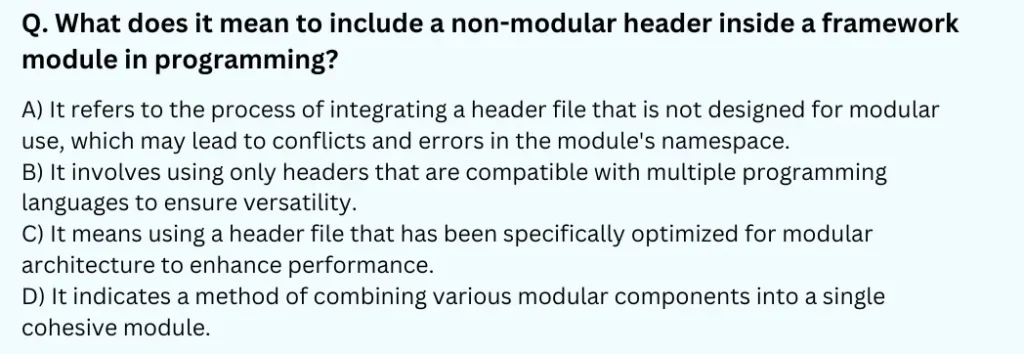Homework Help: Questions and Answers: What does it mean to include a non-modular header inside a framework module in programming?

A) It refers to the process of integrating a header file that is not designed for modular use, which may lead to conflicts and errors in the module’s namespace.
B) It involves using only headers that are compatible with multiple programming languages to ensure versatility.
C) It means using a header file that has been specifically optimized for modular architecture to enhance performance.
D) It indicates a method of combining various modular components into a single cohesive module.
Answer
First, let’s understand what framework module and non-modular header are:
A framework module is a self-contained unit of code that follows modular programming principles. It typically has well-defined interfaces and dependencies.
A non-modular header is a header file that wasn’t designed with modularity in mind. It may contain global declarations, macros, or other elements that could conflict with other parts of the code.
Given Options: Step by Step Answering
a) It refers to the process of integrating a header file that is not designed for modular use, which may lead to conflicts and errors in the module’s namespace.
- Including a non-modular header in a modular system could lead to issues, such as namespace conflicts or unexpected behavior, because non-modular headers don’t follow the same rules as modular ones.
b) It involves using only headers that are compatible with multiple programming languages to ensure versatility.
- This description does not directly relate to the concept of modular versus non-modular headers but rather talks about compatibility across languages.
c) It means using a header file that has been specifically optimized for modular architecture to enhance performance.
- This describes a modular header, but the question specifically refers to non-modular headers.
d) It indicates a method of combining various modular components into a single cohesive module.
- This refers to combining different modular parts, not specifically the use of a non-modular header.
Final Answer
Based on the above analysis, the correct answer is:
a) It refers to the process of integrating a header file that is not designed for modular use, which may lead to conflicts and errors in the module’s namespace.
This is correct option because:
- It accurately describes the situation of using a non-modular header in a modular context
- It acknowledges the potential problems (conflicts and errors) that can arise
- It specifically mentions the namespace issues, which is a key concern when mixing modular and non-modular code
Learn More: Homework Help
Q. Which of the following is a good practice for protecting your identity online?
Q. How can computers contribute toward creating a “paperless society”?